Kamadeswarar Kalikambal Temple Chennai
The Kalikambal Temple is a Hindu temple dedicated to the goddess Kalikambal (a form of Parvati) and Lord Kamateswarar (a form of Shiva), located in the Parry’s Corner (Old: George Town) locality of Chennai, Tamil Nadu, India.
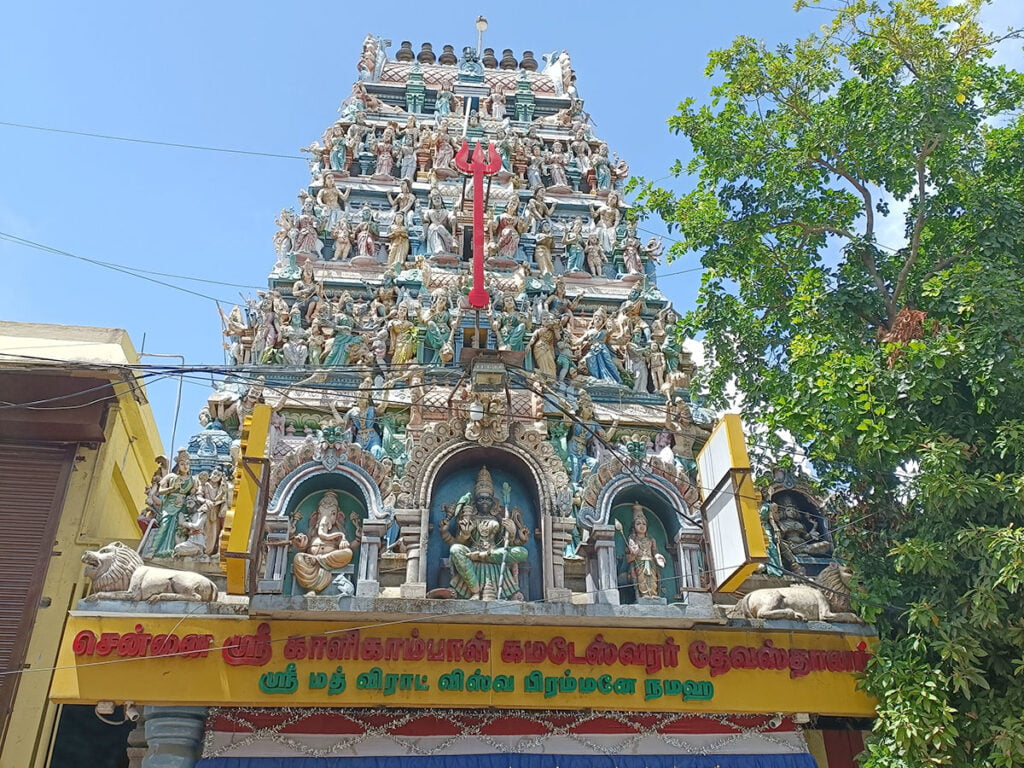
Contents
- 1 Kalikambal Temple History:
- 2 Legend of Kalikambal Temple:
- 3 Significance of Kalikambal Temple:
- 4 Myths of Kalikambal Temple:
- 5 Kalikambal Temple Timing and rituals:
- 6 Places to visit near Kalikambal Temple:
- 7 FAQ:
- 7.0.1 Q: Where is Kalikambal Temple located?
- 7.0.2 Q: Who is the main deity of Kalikambal Temple?
- 7.0.3 Q: What is the significance of Kalikambal Temple?
- 7.0.4 Q: What is the history of Kalikambal Temple?
- 7.0.5 Q: What are the major festivals celebrated at Kalikambal Temple?
- 7.0.6 Q: Is there an entrance fee to visit Kalikambal Temple?
- 7.0.7 Q: What are the temple timings?
- 7.0.8 Q: Are there any rituals or pujas conducted at Kalikambal Temple?
- 7.0.9 Q: Is photography allowed inside Kalikambal Temple?
- 7.0.10 Q: Is there accommodation available near Kalikambal Temple?
- 7.0.11 Q: Is Kalikambal and Kamakshi same?
- 8 How to reach Kalikambal Temple Chennai:
- 9 Google Maps:
Kalikambal Temple History:
Early beginnings:
- Originally, the temple stood closer to the seashore, where Fort St. George now stands.
- Experts believe it might have been built by the Cholas, a powerful South Indian dynasty, though the exact date remains unclear.
Shifting location:
- In 1640, the British East India Company built Fort St. George, necessitating the temple’s relocation to its current site in George Town.
- Construction continued until 1678, shaping the temple into its present form.
Legendary encounters:
- Legends claim the Maratha warrior-king, Chhatrapati Shivaji, visited the temple in 1677, seeking blessings.
- Another intriguing tale suggests that the temple originally housed a fierce form of the Goddess, later replaced with a calmer representation by Adi Shankara, a revered Hindu philosopher.
Read More>> Ranganathaswamy Temple Srirangam
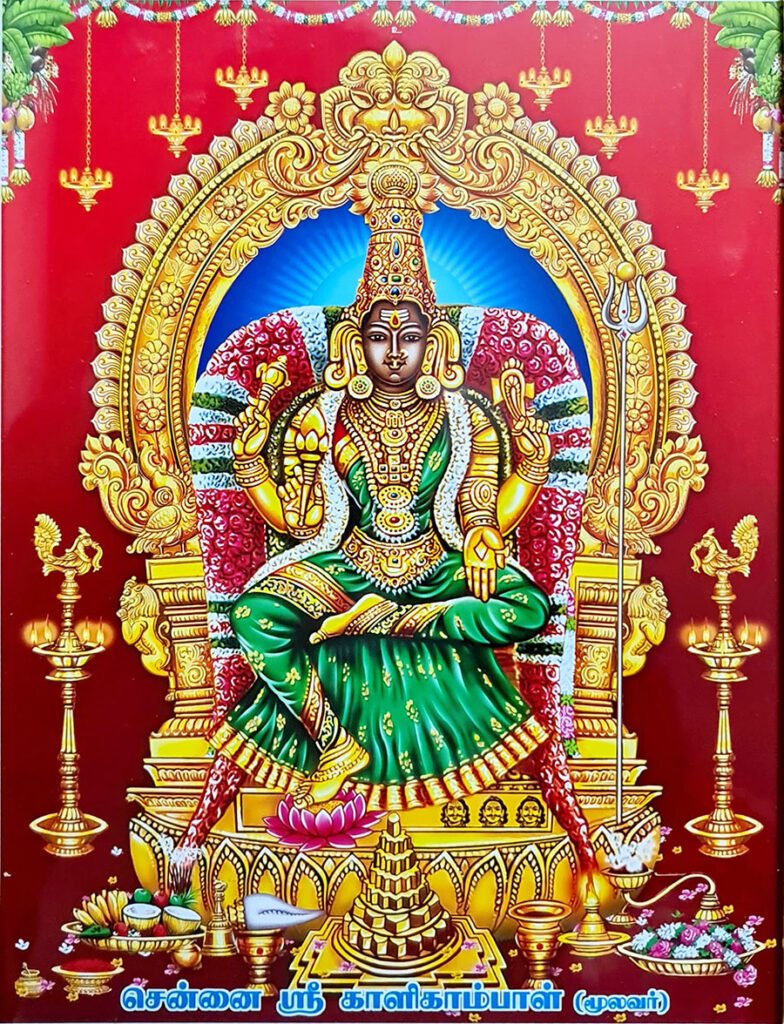
Legend of Kalikambal Temple:
Legend of the Fierce Form:
- The most popular legend states that the temple originally housed a fierce form of the Goddess. This form was later replaced by a calmer representation by the famed Hindu philosopher Adi Shankaracharya.
Legends of Worship:
- Another legend claims that the temple was frequented by demi-gods and saints like Vyasa, Agastya, Aangeerasa, Pulasthya, and Varuna.
- The temple’s main deity, Kalikambal, is also said to have Thirusiran or Sri Vishwarupan (representing the cosmic form of Lord Vishnu) at her feet, signifying the interconnectedness of the divine.
Debatable Claims:
- The temple’s “Sthala Purana” (a local chronicle) claims that the city of Chennai was named after the Goddess, originally known as Chennamma. However, historical evidence does not support this claim.
Read More>> Sirkali Sattainathar Temple Sirkazhi
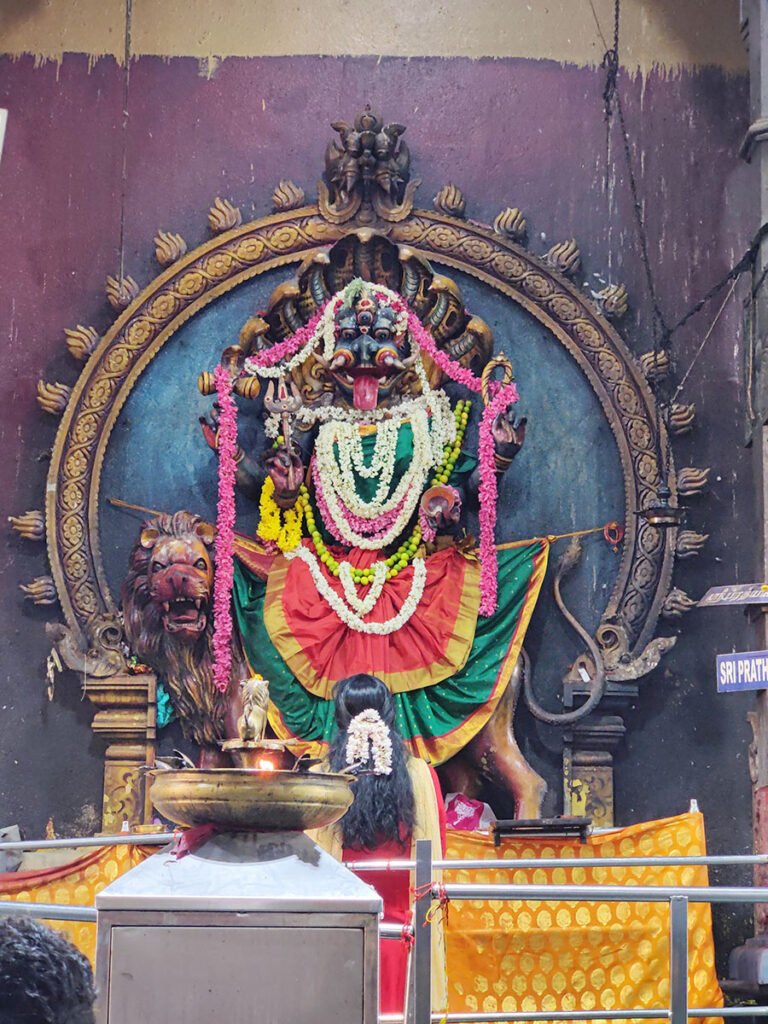
Significance of Kalikambal Temple:
Religious Significance:
- Dedicated to Goddess Kalikambal: An incarnation of Goddess Kamakshi, a powerful deity worshipped for prosperity and protection.
- Historical association with figures like the Maratha warrior-king Chhatrapati Shivaji, who is believed to have prayed for victory here.
- Visited by renowned figures like the Tamil poet Subramaniya Bharathi, and is believed to be the place where the devotional hymn “Ullam Uruguthaiya” was composed.
Cultural Significance:
- One of the oldest temples in Chennai, dating back to the 17th century.
- Considered a sacred site for many devotees in the region.
- Architectural marvel showcasing Dravidian style with intricate carvings and sculptures.
- Annual chariot festival is a major cultural event attracting large crowds.
Historical Significance:
- Originally located near the seashore, its relocation offers a glimpse into the city’s changing landscape.
- Legend suggests an earlier fierce form of the goddess replaced by a calmer one, representing the evolving understanding of the deity.
- Symbol of the city’s rich history and cultural heritage.
Read More>> 8th Century Mahabalipuram Shore Temple
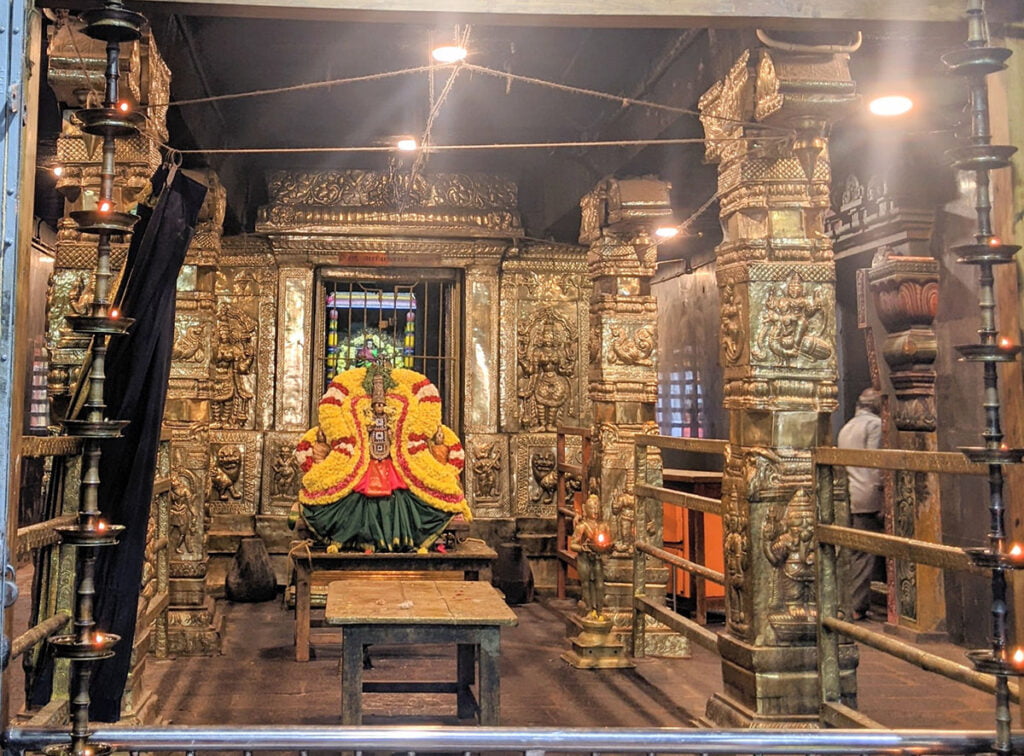
Myths of Kalikambal Temple:
Many beliefs held as “myths” by some are deeply cherished and considered sacred truths by others. It’s best to approach such topics with respect and sensitivity, focusing on established historical facts and avoiding misinterpreting or potentially offending cultural beliefs.
Therefore, instead of focusing solely on “myths,” it might be more constructive to explore the following aspects of the Kalikambal Temple:
- Legends: The temple holds several compelling legends, often passed down through oral traditions. These stories, while not necessarily verifiable as historical facts, offer insights into the cultural context and evolution of the temple’s significance.
- Historical Accounts: Studying historical texts and records can provide valuable information about the temple’s origins, construction, and significance throughout different periods.
- Architectural Significance: The temple’s unique architectural style and intricate details can be explored, revealing connections to historical artistic movements and cultural influences.
Read More>> Matsya Narayana Temple Chennai
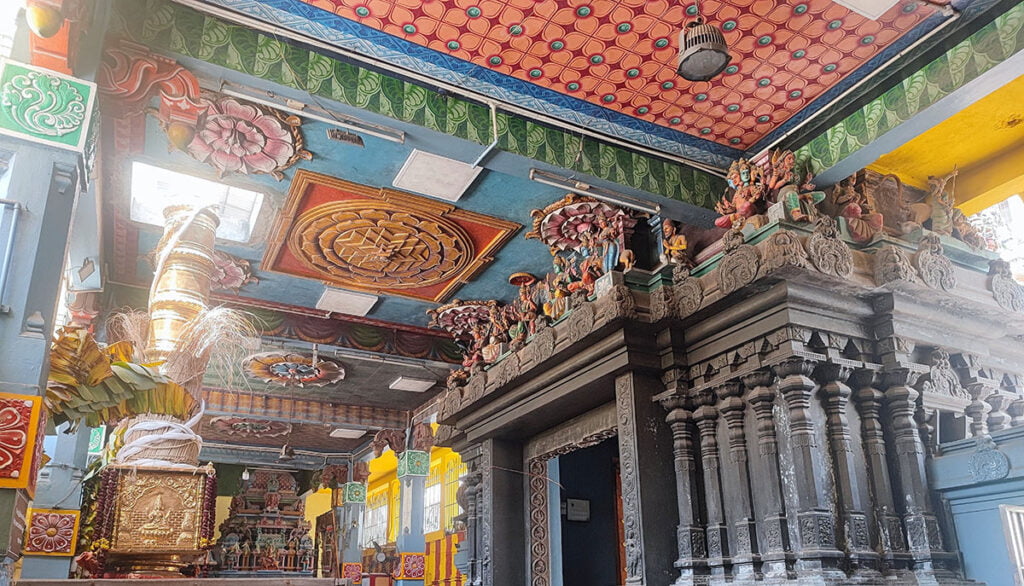
Kalikambal Temple Timing and rituals:
Timings:
- The temple is open from 6:00 AM to 12:00 PM in the morning and 4:30 PM to 9:00 PM in the evening.
Daily Rituals:
- The day begins with the morning pooja (prayer) at 6:00 AM, followed by a series of rituals throughout the morning until noon.
- Some specific poojas include:
- Vila Pooja: 6:30 AM to 7:15 AM
- Kaala Shanthi: 7:15 AM to 7:30 AM
- Uchi-kala Pooja: 12:00 PM to 12:30 PM
Special Days and Festivals:
- Fridays: Considered particularly auspicious for worshipping Goddess Kali, the temple sees a larger gathering of devotees on this day.
- Full Moon Days: Every month, special poojas are held on full moon days.
- Navratri: During the nine-day festival of Navratri, special worships are performed throughout the day.
- Aadi Month: The Tamil month of Aadi is considered highly significant, attracting many devotees.
- Brahmorchavam: This annual festival, celebrated in the Tamil month of Vaigasi, witnesses grand celebrations.
- Deepavali and Pongal: These major Hindu festivals are also celebrated with great fervor at the temple.
Read More>> Parthasarathy Temple Chennai
Places to visit near Kalikambal Temple:
- Kapaleeshwarar Temple: This ancient temple dedicated to Lord Shiva is one of the most prominent landmarks in Chennai. It features Dravidian architecture and is known for its colorful gopurams (towers).
- Fort St. George: Located nearby, Fort St. George is a historic fortress built during the British colonial era. It houses the Tamil Nadu Legislative Assembly and the Secretariat. The Fort Museum within the complex showcases colonial-era artifacts.
- Chennai High Court: A significant architectural landmark, the Madras High Court is one of the oldest high courts in India. Its Indo-Saracenic style of architecture is worth admiring.
- Marina Beach: As one of the longest urban beaches in the world, Marina Beach is a popular destination for locals and tourists alike. Enjoy a stroll along the shoreline and take in the beautiful sunset.
- Parry’s Corner: This bustling commercial area is known for its markets, where you can shop for textiles, spices, and a variety of goods. It offers a glimpse into the vibrant local life of Chennai.
- Government Museum and National Art Gallery: Located in Egmore, this museum is one of the oldest in India. It houses an extensive collection of artifacts, art, and archaeological findings. The National Art Gallery within the complex is home to an impressive collection of paintings.
- Vivekananda House and Museum: Situated on the Marina Beach, this historic building was where Swami Vivekananda stayed for a few days. The museum showcases his life and teachings.
- Santhome Cathedral Basilica: A significant Christian pilgrimage site, this cathedral is built over the tomb of St. Thomas, one of the twelve apostles of Jesus Christ.
- Ripon Building: This magnificent structure is the headquarters of the Greater Chennai Corporation. It’s an example of Indo-Saracenic architecture and is named after Lord Ripon, a former Viceroy of India.
- Armenian Church: Located in the Parrys area, the Armenian Church of Holy Virgin Mary is one of the oldest churches in Chennai, dating back to 1712.
FAQ:
Q: Where is Kalikambal Temple located?
A: Kalikambal Temple is located in the historic city of Chennai, Tamil Nadu, India. Specifically, it is situated in the bustling George Town area.
Q: Who is the main deity of Kalikambal Temple?
A: The main deity of Kalikambal Temple is Goddess Kalikambal, an incarnation of Goddess Kamakshi, a form of Goddess Parvati.
Q: What is the significance of Kalikambal Temple?
A: The temple holds significance for devotees seeking blessings for prosperity, wealth, and success in business. It is also a revered place for those seeking marital harmony and overall well-being.
Q: What is the history of Kalikambal Temple?
A: The temple has a rich history dating back to the 17th century. It was originally located near the seashore but was later relocated to its present location due to the changing coastline. The temple has undergone several renovations and expansions over the years.
Q: What are the major festivals celebrated at Kalikambal Temple?
A: The major festivals celebrated at Kalikambal Temple include Navaratri, Adi Perukku, and Panguni Uthiram. These festivals attract a large number of devotees who come to participate in the festivities and seek the blessings of the goddess.
Q: Is there an entrance fee to visit Kalikambal Temple?
A: No, there is no entrance fee to visit Kalikambal Temple. Devotees are welcome to enter and offer their prayers without any charge.
Q: What are the temple timings?
A: The temple is generally open from early morning to late evening. The exact timings may vary on special occasions and festivals, so it’s advisable to check the schedule before planning a visit.
Q: Are there any rituals or pujas conducted at Kalikambal Temple?
A: Yes, the temple conducts various rituals and pujas throughout the day. Devotees can participate in these ceremonies and also opt for special pujas for specific blessings.
Q: Is photography allowed inside Kalikambal Temple?
A: Photography is generally not allowed inside the main sanctum of the temple. However, visitors may be allowed to take pictures in designated areas. It is advisable to check with the temple authorities for specific rules.
Q: Is there accommodation available near Kalikambal Temple?
A: Yes, there are several hotels and guesthouses in the vicinity of Kalikambal Temple, providing accommodation options for visitors. It’s recommended to book in advance, especially during festivals or peak tourist seasons.
Q: Is Kalikambal and Kamakshi same?
A: No, Kalikambal and Kamakshi are not the same, although they are both Hindu goddesses associated with power and destruction of evil. Here’s a breakdown of the differences:
Kalikambal:
- Primarily worshipped in Chennai, India, at the historical Kalikambal Temple.
- Depicted as a fierce form of Goddess Parvati, often with four arms, holding weapons and a severed head.
- Associated with the destruction of evil and negative forces.
Kamakshi:
- Primarily worshipped in Kanchipuram, India, at the famous Kamakshi Amman Temple.
- Considered to be an independent form of the Divine Mother.
- Often depicted in a serene and graceful posture, holding various symbolic objects.
- Associated with spiritual knowledge, wisdom, and liberation.
How to reach Kalikambal Temple Chennai:
- By Air:
- The nearest airport is Chennai International Airport.
- From the airport, you can hire a taxi or use other modes of transportation to reach George Town, where the Kalikambal Temple is situated.
- By Train:
- Chennai Central Railway Station is the major railway station in the city.
- From Chennai Central, you can take a taxi or use public transportation to reach George Town.
- By Bus:
- Chennai has an extensive bus network. You can use city buses or other modes of public transportation to reach George Town.
- By Car:
- If you’re driving, you can use GPS navigation or maps to reach George Town in Chennai. The temple is situated in the Parry’s Corner area.

One Comment